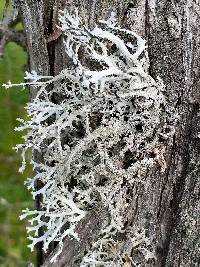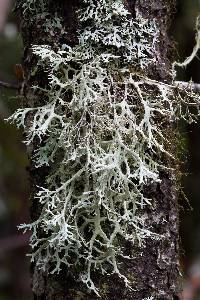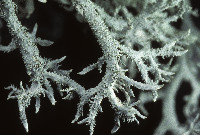
Consortium of Lichen Herbaria
- building a Global Consortium of Bryophytes and Lichens as keystones of cryptobiotic communities -
- Home
- Search
- Images
- Species Checklists
- US States: O-Z >
- US National Parks
- Central America
- South America
- US National Parks
- Southern Subpolar Region
|
|
|
|
Family: Parmeliaceae
[Parmelia consocians Vain.] |
Nash, T.H., Ryan, B.D., Gries, C., Bungartz, F., (eds.) 2002. Lichen Flora of the Greater Sonoran Desert Region. Vol 1. Thallus: foliose to subfruticose to caespitose, 4-10 cm across, separate, lobate lobes: linear, 0.5-1.5 mm wide, subdichotomously branched, loosely imbricate; apices: usually subtruncate, eciliate upper surface: light gray to gray, smooth, plane to rugulose, shiny or dull, weakly maculate, usually epruinose isidia: abundant, cylindrical; tips: darker than the thallus, sometimes abrading, but not sorediate; soredia absent medulla: white, loosely packed lower surface: tan to black, sometimes mottled white, naked, channeled, erhizinate, attached by basal holdfasts Apothecia: not seen Pycnidia: laminal or marginal, immersed or emergent to sessile conidia: not seen Spot tests: upper cortex K+ yellow, C-, KC-, P+ yellow; medulla K-, C+ red, KC+ red, P- Secondary metabolites: upper cortex with atranorin and chloroatranorin; medulla with lecanoric acid (major). Substrate and ecology: usually on conifers (especially pines) in open pine-oak forests World distribution: neotropics from northern Mexico to Central America Sonoran distribution: in the Sierra Madre Occidental, Chihuahua and Sinaloa, at 1500-2300 m. Notes: In comparison with the European P. furfuracea, which can also be isidiate, P. consocians is a less robust species with narrower lobes. Although both may have a C+ medulla, in P. furfuracea it is due to olivetoric acid; in P. consocians, due to lecanoric acid. |
|
|
|
Powered by Symbiota

























































































